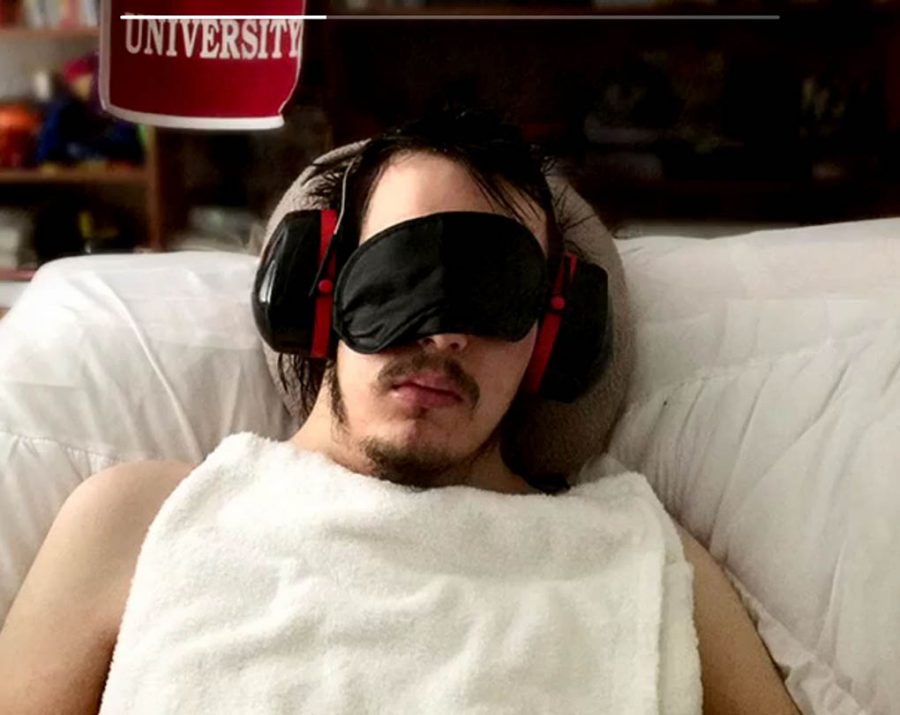Former Cal student struck by disease
Cal alumnus Tom Camenzind has had his life changed by a disease called M.E. He is now unable to perform simple tasks and go about his life as usual, and has been reduced to lying in bed all day.
For Cal High Alumnus and Stanford student Tom Camenzind, life has approached a standstill as the result of the disease M.E./C.F.S.
M.E./C.F.S. affects no less than one to two million people in the U.S. The term itself, myalgic encephalomyelitis, carries a provoking explanation: neuro inflammation of the brain and the spine. Individuals with the disease find the most effortless actions, such as walking, talking, or even concentrating, to be strenuous. Furthermore, due to cognitive impairment, they find it problematic to participate in any sort of lifestyle activity that requires even marginal amounts of comprehension.
“With M.E., I would say you tend to have brain fog where it’s very difficult to think and you have a lack of energy in general,” said Mark Camenzind, Tom’s father.
Unfortunately many people can’t find the words to express the condition of brain fog, therefore exchanging it for generalized terms like headaches or exhaustion.
Fatigue, however, connects to post-exertional malaise, a vital concept that patients with the disease experience.
M.E. has the term post-exertional malaise (PEM) coined to it because the slightest of actions performed by the affected, such as working or exercising, cause them to remain bed-bound and too tired to function for days or even weeks to come.
“Some of the people will do something energetic – it could be fairly minor, just five minutes or so – and they end up getting wiped out for a day or two, or maybe even longer,” said Mark Camenzind, “And for others, they get out for a day and they pay for months.”
In severe cases, patients are too sick to respond or even get up. Some even overexert themselves simply with exposure to light or by sensing another person in the room.
Tom, who suffers from some of these severe symptoms, is currently bed-ridden. His eyes are covered, and he has earmuffs with a noise reduction rating of thirty decibels strapped to his head.
Prior to developing M.E., however, Tom had graduated from Cal High in 2012 and was a bright college student enjoying his second year at Stanford.
“Tom was the happiest I’d ever seen him,” said Dotty Camenzind, Camenzind’s mother. “He loved Stanford, he loved computer science, he loved his friends, he loved his classes, and he was excited about the research he was going to do.”
Tom began to develop the disease in January of 2014, when he came down with the flu and a persistent set of chills and shakes.
“He was nineteen, just getting ready to turn twenty,” Dotty Camenzind said. “But there are different presentations of this disease and Tom had the slow onset.”
The pinpointed cause of M.E. is ambiguous, even to scientists. However, many believe that the progression towards the total deterioration of health begins with a common flu or cold. After that, the disease consequently jeopardizes the immune system of the victim, as seen with Tom.
“After the flu, he couldn’t seem to recover very well,” said Mark Camenzind. “Then around February, he got a second cold on top of all that and by this time, he was behind in class because he was sick and trying to catch up, but he’s overworked himself and he crashed on the weekends.”
On the same spectrum, CEO of Solve ME/CFS, Carol Head, was one of the many to endure the disease. For reasons still unknown to scientists, a select few manage to gradually somewhat recover from the disease. Head was one of these lucky few.
“I have no idea why I got better and I have no idea why Tom didn’t,” Head said. “It’s a sort of disease that waxes and wanes like many chronic illnesses, but it really dominated my life, completely, and for some period of time I was bed bound. I tried everything under the sun to get better. And I did eventually, over the course of several years, regain function.”
With M.E., however, Head affirms that there hasn’t been a single case where the individual fully recovers, her’s included.
“I’ve been fortunate to live a fairly normal life for the last thirty years, but you know I’m still very careful about not over using my energy. So I’d say I’m ninety-five percent recovered,” she said.
Despite the number of individuals whose lives are restricted socially and physically with this disease, when brought to doctors’ attention, it has been dismissed as nothing but a case of ‘depression’ or ‘laziness’. M.E. is anything but that, even though it is often discounted as such, because patients don’t visually broadcast their symptoms.

“I was passed from doctor to doctor and told I was depressed and to get over it when I had M.E. in the 1980s,” said Head, “But even today most doctors are not familiar with it and don’t diagnose M.E. Really, it’s a chronic debilitating disease with no known cause and no approved therapies or cure that destroys lives.”
People like Tom, who still struggle to cope with M.E., have taken trial-and-error approaches with their bodies to see what might make themselves feel better. Some adjust to the pharmaceuticals or immune modulators given whereas others, such as Tom, seem to react the exact opposite way in that their infirmities only magnify.
Out of the two million in the U.S. that have M.E., there is no concrete barrier that divides who and who can’t get this disease. M.E. can affect people of all ages, regardless of ethnicity or race, although it tends to target females more than males.
Another intriguing statistic about M.E. comes from Linda Tannenbaum, CEO of Open Medicine Foundation, whose foundation finds effective treatments and objective criteria that defines the disease and makes it easier to diagnose.
“M.E./C.F.S. is the most common reason that adolescents are out of school for long periods of time,” she said. “It’s not diagnosed easily, so most parents and kids don’t know they have it. And a lot of people think that the kids are lazy, that they don’t want to study, or have a hard time concentrating because they don’t try hard enough.”
Tannenbaum stresses that it’s important for parents to be aware of the fact that the disease isn’t uncommon in high school kids.
Although this disease happens to be a prevalent factor of many individual’s lives, it currently stands with no FDA approved drugs or therapies, which are all due to the fact that M.E. is underfunded.
“We have to cure people like Tom,” said Tannenbaum. “They have to get better. It’s up to us to find a cure and we have to do it quickly.”










Bridgitte Descoins • Oct 16, 2016 at 10:06 am
I am truly sorry for this young man. I know what it is like to be where he is. If we can all help each other to find the answers as mostly we go blindly from one doctor to the next trying to help ourselves because they are unable to. I wonder if you could put me on to a doctor who would prescribe me anti viral meds. I have been trying to live with this disease since 2001. If you can help that would be wonderful. Thank you.
Mary Gelpi • Oct 16, 2016 at 3:03 am
Thank you for this article, and Mary Schweitzer thank you for such a well thought out comment and plea to the public. If anyone else is reading, you can help us receive far more funding from the NIH by signing this petition. I am 31 but was a competitive gymnast and diagnosed at age 9, I wrote this petition for the millions who are too sick to fight for what they deserve in terms of healthcare. It is insane the level of neglect and dismissal this disease is given the economical impact (8 billion a year in lost productivity. If the extensive suffering of millions of people wasn’t enough by. Now, I would think the financial toll it’s taking in the country would be burdensome enough to motivate change. But. Nothing has changed, for THIRTY years. The time for change is now, and anyone from any country can help by taking THIRTY seconds to sign their name on this petition . I know that once we delve into the M.E. research we will find answers for other diseases and chronic illness as well. But first we have to speak up. Please, please help our voices be heard. We are 709 signatures away from 40,000. Thank you to everyone who has joined in our fight, we desperately need you. Thank you.
https://www.change.org/p/increase-research-funding-for-me-cfs
Anthea • Oct 15, 2016 at 8:05 pm
It always makes me sad to hear about people who are so debilitated by this disease that they can’t tolerate any light or sound. I have ME and it’s gradually becoming worse; my biggest fear is that I’ll become bedridden, or even be unable to tolerate light and sound, the way Tom can’t. It gives me hope that people like Tom’s parents, Carol Head, and even Mary and Bill in the comments above, are sharing their stories and helping raise awareness.
Paolo • Oct 14, 2016 at 5:29 am
Dear Mary Schweitzer,
Could I ask the name of the drug? It is Ampligen, I guess.
Thank you for your message.
Stephanie Stultz • Oct 14, 2016 at 4:52 am
It was a great article and so representative of the suffering of so many, many severely affected patients, myself included. I just wish there was another term that was used in the community instead of using the word ‘malaise’…..(PEM) The word ‘malaise’ seems so benign and seems to conjure up a view of someone reclining in one of those old fashioned ‘fainting couches’ like in days of old, with hand to forehead. It’s the same complaint with using the word ‘fatigue’, even though it’s become accepted. It simply doesn’t convey the gravity of ME/CFS. It should be called something like Post Exertional Collapse!!!
Tina Sprouse • Oct 13, 2016 at 8:38 pm
I’ve been sick for 11 years now, it started with being hospitalized with a severe sinus infection for a week. When I got home I never recovered my energy, blood work indicated that my thyroid was under functioning and I had mono. I was put on meds for my thyroid and told it would take at least a year to recover from mono since I was 38. I gave it a year and nothing changed. It took a couple of years to get diagnosed and the only reason it happened that quickly was because I pursued my health, not because of my Drs. Once I was diagnosed it took probably another 5-6 years to find a Dr. Who could help. I went from Dr to Dr. From specialists to specialists. I got very lucky about 3 years ago I changed Drs again and found a GP who ran the regular tests and since I have PTSD suggested I see a psychiatrist. That was what really changed things for me, My first psychiatrist had military experience and started me on some very helpful meds. After a year or so she moved out of state and my second psychiatrist had beneficial sleep and neuro knowledge. He tweaked my meds and I’m doing the best I have in a long time.
I can concur with most of what Mary said. It is such a debilitating illness and hard to tack it down. I really feel for Tom. I have never been that ill and I really pray that his situation turns around for the better. It sucks to have CFS but to be that young is even worse.
Stephanie Schmidt • Oct 11, 2016 at 12:37 pm
I came down with the Epstein-Barr virus nearly 30 years ago at age 19 and never fully recovered. Trying to work more than part-time landed me in bed for weeks at a time. A severe relapse three years ago, brought on in a foolish attempt to build ‘stamina’ by increasing activity, left me house and bedbound. Excellent articles like this, that specifically and accurately describe ME/CFS, help get the word out that this disease entails much more than being “tired all the time.” There is an urgent need for better understanding of the disease, adequate funding, and treatment. Thank you for your coverage of this story and best wishes to Tom and his family.
Klaus • Oct 10, 2016 at 4:37 am
Hello Tom, I am really sorry for you that you got this disease at such a young age. I myself am also affected, I became ill in February 2015, just as with you everything started with a viral infection and has not let me loose since then. However, I was already 51 years old and the severity is not as strong as with you. Dear Tom, I wish you great strength and do not give hope that it will be better in the future
Many greetings Klaus from Germany
Bill Clayton • Oct 7, 2016 at 4:34 am
I’m so sorry to hear of Tom’s situation. I myself have had ME for over 10 years now and know what he’s going through. I’m in the UK, and our suggested figure of sufferers is 250,000. That means that in my area of York, there are likely to be around 800 people of all ages with ME. Our problem is awareness. We have to work on that. I’m working on that in York by having a support group, but working on bringing businesses on board to help. My website at http://www.York-ME-Community.org will hopefully give an ideal of what can be done. First we need to raise awareness, then belief will follow and then the funds to find a cure for this beast. Good luck Tom and take care.
Erik Johnson • Oct 5, 2016 at 9:11 pm
I see that the former “CFS community” has decided to take over the “ME” name so they won’t be bothered with investigating CFS.
Which is actually what the CDC hoped for when they gave the syndrome a dumb name.
Be that as it may, I believe this is a mistake, for they are completely abandoning some very good clues.
Such as the way mold toxins are a mediating factor in the disease.
But.. if they wish to demolish clues.. it’s their loss.
Mary Schweitzer • Oct 5, 2016 at 8:32 pm
Thank you for such an informative and compassionate article.
I have severe ME, but I have been lucky in being in studies that showed I had immune defects and viruses (including active HHV-6A and CMV in my spinal fluid, both known to be neurotropic), and I am on an experimental immune modulator that keeps them in check. I’m not normal, but believe me, it’s intoxicating to be able to walk, drive a car, write like I’m doing in this comment, read again, take care of myself.
I wanted to explain brain fog a bit. Canadian physician Byron Hyde edited a book on ME roughly 25 years ago, just after the CDC had decided they wanted to call it “chronic fatigue syndrome” (in 1988). The book is, unfortunately, out of print. But it had an excellent chapter on the neurological symptoms of the disease. I felt as if he had sat in my living room and written down what I did, it was so close to what it felt like.
I had expressive aphasia – I would insert the wrong word in a sentence (right category, but wrong word), or not be able to say what i was thinking at all. I had ataxia – it was as if the floor was moving – I didn’t know where I was in space. (Note, I wasn’t dizzy; but I had to hold on to walls and furniture, with a little help from my golden retriever who’d prop me up on the other side). I suffered from disorientation. I could be one block from my house and not know where I was. I was sensitive to light and sound – forever asking people to turn off the light or turn down the tv.
I suffered from absence seizures. (I called that “the pause.”) I could be walking across a room and just … stop. Eventually I’d finish walking across the room – and I didn’t know i had stopped. (My son experimented by giving me a gentle push and that would get me started again.) The same thing might happen with a sentence, and (unlike with stammerers), giving me the right word would help me finish the thought.
I was a professor of history – you could say I was a professional reader. But reading got so difficult that I could not read a comic strip because I couldn’t remember what was in the first panel by the time I got to the fourth. It was the same if somebody called and wanted me to write down a phone number. They had to do it one numeral at a time, because I could not remember 2 numerals long enough to write them down, let alone 7. Then I didn’t always remember someone called, or where I wrote it down.
At its craziest, brainfog can be funny (to us) – you put the milk in the microwave and the silverware in the refrigerator and your shoes in the dryer. I remember trying to stuff a roll of paper towels into a Mr. Coffee machine. My best brainfog incident (we have contests on internet) was when I poured an entire pot of coffee into a silverware drawer convinced it was a cup – until I saw the pretty dark brown waterfall and realized I was holding an empty pot of coffee. And let me assure you that if you are holding a cup of coffee in your right hand, it’s not a good idea to turn a doorknob with the same hand.
Eventually I got so sick that there wasn’t much fun to be had in brainfog. I would lie in the dark, listening to my favorite movies – movies I had watched enough times that I could disappear into them just listening. And in that I was lucky. Listening to a movie was not painful.
You know time is passing by. There is no hope on the horizon (for me, that lasted four years until I was able to get into those studies; and it has returned when, on two occasions, I lost the drug and relapsed to where I had been before – the second time, knowing what was going to happen, was truly horrible).
At least one million American adults have this disease. But at most, 15% are diagnosed. That means 850,000 patients out there have no idea what is wrong with them. Studies tend to show that 25% of patients are housebound and/or bedridden; 90% of patients cannot perform consistently enough to be able to hold down a full or part-time job. How do these people live? I don’t know. What I do know is we need help urgently.
And that is why I was so pleased to see this article. It was so well-written – and it was written by a healthy. (That’s what we call you people.) We need help from healthy people, Thank you so very much.
And for the college students who might be reading this, the virus that led me to this calamity was Epstein-Barr Virus (mono). I had it when I was an undergraduate, but some vicious strain swept through my university when I was a professor – all the students got sick, and many of us professors did as well (which is unusual). Watch out for EBV outbreaks. If you get sick, REST. Do NOT push yourself.
I did not – I was up for tenure, and I could not stop moving for long. I got mostly better, then pushed through chronic bronchitis for the next four years until the day I had a blackout in my office, and when I came to, could not understand a word of what was on the papers in my lap – they might as well have been written in cyrillic alphabet. But a fellow professor who got sick at the same time I did, was given the chance by his university to stay in bed – for two years – then he slowly got better. We think that’s the best advice we can give you, if you find yourself far more sick than you should be from EBV or some other virus.
Mostly we need research, and for research, we need funding. NIH gives us less than $6 per person per day – if we were funded on a level with MS, that number would be $250. There are people at NIH and CDC who actually think this is psychosomatic (a somatoform condition, to be technically accurate). Please, help us get NIH to treat this as the serious disease it is – before someone you love gets it too.